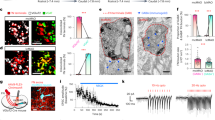Abstract
The connections between the cerebellar cortex, the complex of cerebellar and vestibular nuclei and the inferior olive form a closed loop that is organized in parallel modules. In this chapter, we describe general physiological aspects of its primary components, highlighting parts of the neocerebellum and vestibulocerebellum that are involved in the generation of eye blinks and compensatory eye movements, respectively.
Access this chapter
Tax calculation will be finalised at checkout
Purchases are for personal use only
Similar content being viewed by others
References
Badura A, Schonewille M, Voges K et al (2013) Climbing fiber input shapes reciprocity of Purkinje cell firing. Neuron 78:700–713
Benedetti F, Montarolo PG, Strata P, Tempia F (1983) Inferior olive inactivation decreases the excitability of the intracerebellar and lateral vestibular nuclei in the rat. J Physiol 340:195–208
Bengtsson F, Jirenhed DA, Svensson P, Hesslow G (2007) Extinction of conditioned blink responses by cerebello-olivary pathway stimulation. Neuroreport 18:1479–1482
Cerminara NL, Rawson JA (2004) Evidence that climbing fibers control an intrinsic spike generator in cerebellar Purkinje cells. J Neurosci 24:4510–4517
De Zeeuw CI, Wentzel P, Mugnaini E (1993) Fine structure of the dorsal cap of the inferior olive and its GABAergic and non-GABAergic input from the nucleus prepositus hypoglossi in rat and rabbit. J Comp Neurol 327:63–82
De Zeeuw CI, Wylie DR, DiGiorgi PL, Simpson JI (1994) Projections of individual Purkinje cells of identified zones in the flocculus to the vestibular and cerebellar nuclei in the rabbit. J Comp Neurol 349:428–447
De Zeeuw CI, Hoebeek FE, Bosman LWJ et al (2011) Spatiotemporal firing patterns in the cerebellum. Nat Rev Neurosci 12:327–344
De Zeeuw CI, Ten Brinke MM (in press) Motor learning and the cerebellum. In: Mayford MR, Dudai Y (ed) Learning & memory by Kandel. CSH press, New York
Marshall SP, Lang EJ (2009) Local changes in the excitability of the cerebellar cortex produce spatially restricted changes in complex spike synchrony. J Neurosci 29:14352–14362
Medina JF, Nores WL, Mauk MD (2002) Inhibition of climbing fibres is a signal for the extinction of conditioned eyelid responses. Nature 416:330–333
Oscarsson O (1979) Functional units of the cerebellum – sagittal zones and microzones. Trends Neurosci 2:143–145
Person AL, Raman IM (2011) Purkinje neuron synchrony elicits time-locked spiking in the cerebellar nuclei. Nature 481:502–505
Ruigrok TJH (2011) Ins and outs of cerebellar modules. Cerebellum 10:464–474
Winkelman BHJ, Belton T, Suh M et al (2014) Nonvisual complex spike signals in the rabbit cerebellar flocculus. J Neurosci 34:3218–3230
Witter L, Canto CB, Hoogland TM et al (2013) Strength and timing of motor responses mediated by rebound firing in the cerebellar nuclei after Purkinje cell activation. Front Neural Circuits 7:133
Zhou H, Lin Z, Voges K et al (2014) Cerebellar modules operate at different frequencies. eLife 3:e02536
Author information
Authors and Affiliations
Corresponding author
Editor information
Editors and Affiliations
Rights and permissions
Copyright information
© 2016 Springer International Publishing Switzerland
About this chapter
Cite this chapter
Broersen, R., Winkelman, B.H.J., Ozyildirim, O., De Zeeuw, C.I. (2016). Physiology of Olivo-Cerebellar Loops. In: Gruol, D., Koibuchi, N., Manto, M., Molinari, M., Schmahmann, J., Shen, Y. (eds) Essentials of Cerebellum and Cerebellar Disorders. Springer, Cham. https://doi.org/10.1007/978-3-319-24551-5_44
Download citation
DOI: https://doi.org/10.1007/978-3-319-24551-5_44
Published:
Publisher Name: Springer, Cham
Print ISBN: 978-3-319-24549-2
Online ISBN: 978-3-319-24551-5
eBook Packages: Biomedical and Life SciencesBiomedical and Life Sciences (R0)




